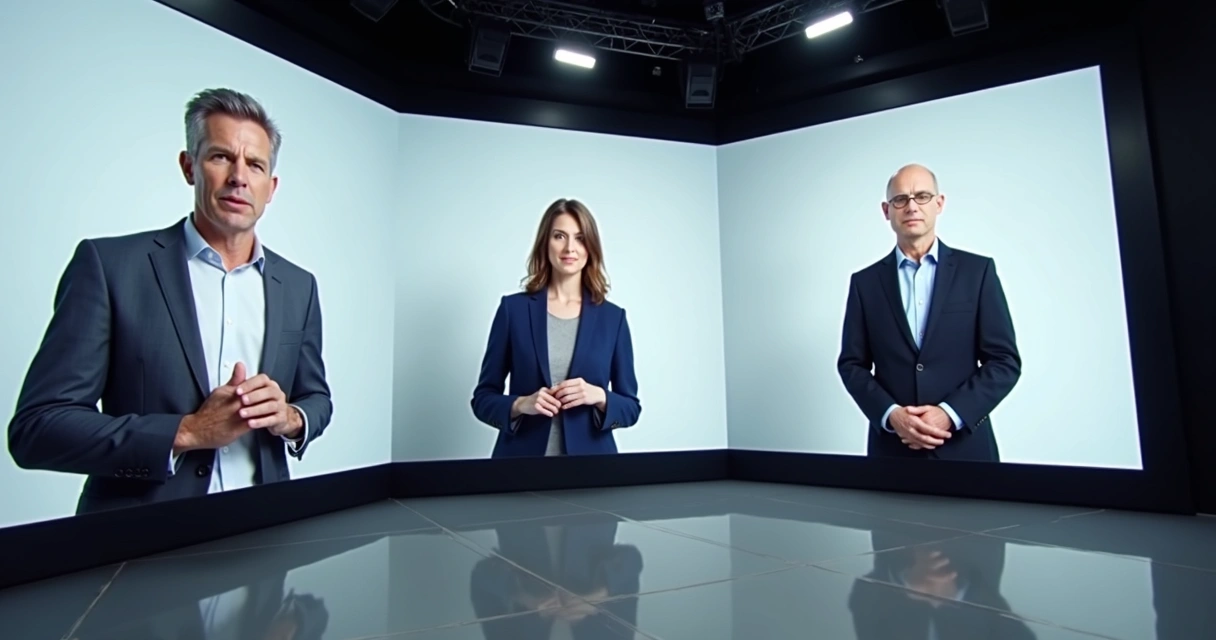You have seconds. Maybe even less. In today's fast-moving world of Meta advertising, catching someone's eye, holding their attention, and inspiring them to take action is no small achievement. It takes more than just bright images or clever headlines; it’s about the rare combination of message, creativity, and data. This is where the power of persuasive messaging and AI-powered tools, such as Automads, comes into play for marketers, agencies, and brands of all sizes.
As you journey through this article, you’ll discover a reliable path for crafting highly effective promotional content for Meta Ads and other major social platforms. We’ll share actionable techniques, surprising insights from industry research, practical examples, and ways the adoption of next-generation tools is reshaping how teams create and test multiple campaign ideas. Even if your last campaign flopped—or you just want to boost your best results even further—there’s something here that can help you find what works.
Understanding Meta Ads and the evolving ad copy landscape
Meta Ads offers one of the world’s most dynamic ecosystems for brands wanting to connect with precise, motivated audiences. Yet the challenge is universal: everyone is running ads. The fight for attention is tougher than ever, and average users scroll past hundreds of messages each day, barely registering most.
So, how do you rise above the noise? It starts at the root: your message. While images and videos drive engagement, your written words act as the bridge between interest and action. If your message fails to strike a chord, the campaign fizzles—no matter your budget.
- Relevance: Your message must fit the moment, platform, and audience expectation.
- Emotion: Great messages evoke feelings—curiosity, excitement, urgency, or relief.
- Action: There’s always a goal: a click, a share, a sign-up, a purchase. The message should deliver this intent with clarity and impact.
According to analyses of AI’s expanding role in advertising and marketing, the global market is already well over $12 billion and set to skyrocket by 2028. This explosion isn’t just about speed or automation: it’s about how machines can help us focus creativity where it matters most—shaping better, more compelling narratives.
And yet, a recent study found that ads written by humans outperformed automated versions by 45.41% more impressions and 60% more clicks. The lesson? You need balance. Combine the speed, data, and variation that AI promises, with the creative spark and empathy only people provide. The ideal is never one or the other—it’s both.
How AI changes the process—but not the need for great stories
Not long ago, building multiple messages for campaign testing was slow, tedious, and expensive. You might brainstorm ideas on whiteboards, write drafts, share with creative teams, gather feedback, send for legal review, and finally upload—still not sure which version (if any) would actually resonate.
Machines can speed up creation, but people fuel meaning.
Now, tools like Automads collapse this entire cycle—making it possible to generate dozens of ideas for text, images, or even video (think: AI actors) in seconds. According to a U.S. Chamber of Commerce and Teneo survey, 98% of small businesses use some form of AI tools already, with 40% leveraging generative platforms for things like content and chatbots.
While speed is valuable, what matters most is what you do with it:
- You can instantly test more message variations—opening new pathways for discovery.
- AI surfaces trends or customer preferences by processing vast datasets, finding what works sooner.
- Teams avoid manual burnout, spending more energy refining winners instead of reinventing the wheel.

Automads enables businesses and agencies to bring this to life—producing tailored messages and creative assets in just a few clicks. Still, even the most sophisticated system won’t save a campaign that lacks humanity, empathy, and sharp attention to what truly matters to your audience.
Rooting your message in what your audience wants (not what you offer)
Here’s a simple truth: nobody wakes up thinking about your product. They wake up thinking about themselves—their needs, wants, problems, and ambitions. Marketers sometimes forget this. They focus on features, not what those features mean.
- Features: What your offer is (“24/7 customer service”, “AI-powered dashboard”)
- Benefits: What your customer gets (“never wait for support again”, “spot trends before your competitors”)
If you lead with features, you risk sounding like everyone else. But frame your message with real benefits, and suddenly things get interesting.
“Save hours every week—without lifting a finger.”
See the difference? It’s not about AI or data or dashboards—it’s about a life with more time and less hassle.
- Ask: what changes for my audience if they say yes?
- Paint a picture in as few words as possible.
- Test different angles (aspirational, emotional, humorous, practical).
When using Automads to generate your variations, it’s easy to swap between these angles, testing what resonates and what falls flat. The goal? Find the one message that makes someone think, “That’s exactly what I need.”
The headline is your first (and often last) impression
If you’re doing Meta Ads, headlines are where most people will decide to keep reading or swipe away. The best ones are short, sharp, and focused on a change the reader cares about.
Here are a few headline ideas that sometimes beat long-winded alternatives:
- “Unlock more leads with less effort.”
- “Grow sales on autopilot.”
- “Test ideas in seconds. Scale winners fast.”
- “Don’t let ad fatigue kill your ROI.”
A successful headline is simple, but not vague; bold, but not pushy. And in most cases, it points at a benefit, not just another promise. Use Automads to generate a set of headlines, then test them live—you’ll quickly see which ones earn the most attention.
How to write descriptions that seal the deal
Once a user clicks on a Meta ad headline, they read the supporting text. Here, brevity is your ally. Start with one sentence that clarifies the main gain, then add a supporting detail or proof point. For example:
“Create ten campaign ideas in one minute—AI-powered support to keep your ads fresh every day. No complicated setup needed.”
Or perhaps:
“Multiply your return on every dollar. Our instant system lets you test, learn, and grow faster—without extra staff or slow approvals.”
When using Automads, you can generate dozens of description styles—from concise to narrative, formal to playful. Don’t fret about perfection on the first try. It’s the testing that makes all the difference.
The call to action: making the next step clear
Even if an ad is beautiful and motivating, if it lacks a clear call to action (CTA), results often stall. The CTA is the nudge. It tells the reader exactly what comes next, and removes even the faintest doubt.
- “Start your free trial now.”
- “See ideas in action—no credit card needed.”
- “Claim your spot today.”
- “Test multiple campaigns on us.”
You should shape your CTA around a specific benefit or outcome—something tangible, not generic.
“Not sure yet? Test Automads without commitment—results in seconds.”

Using AI for instant message and creative generation
The gold standard for repeatable success in Meta Ads is the ability to test rapidly, iterate quickly, and deploy what works at scale. This used to be the domain of agencies with big budgets and teams—but now, thanks to platforms like Automads, anyone has access.
AI-powered creative tools allow you to:
- Generate multiple versions of headlines, descriptions, and CTAs instantly, saving countless hours.
- Match messages to different audience segments automatically or by fine-tuning the brief.
- Produce static images and short, actor-led videos for A/B testing with no need for productions or studio costs.
- Maintain visual and message consistency by feeding your style, tone, or branding guidelines into the platform.
The rise of AI means you’re not limited by bandwidth or creative block. Instead, your focus shifts to strategy—what to say, how to say it, and what really moves your audience to act.

Brand consistency matters—especially with automation
One risk with producing dozens of variations is that not all versions will “feel” like your brand. This disconnect can hurt recognition or even dilute trust, especially with repeat exposure. That’s why the smartest teams bake in guidelines at the start.
- Define your core message: What do you stand for? What’s off-limits?
- Specify tone and style rules: Are you friendly, direct, witty, formal?
- Choose your brand language: Taglines, specific phrases, or vocabulary to use/avoid.
- Review and approve variations: Even with automation, manual review for consistency makes a difference.
Tools like Automads let you set these guidelines in advance, so every version—no matter how experimental—still connects back to your core identity. This protects your long-term value, making sure you stand out for the right reasons.
Testing, learning, and improving through data
Here’s a confession: nobody gets it right the first time, every time. The best Meta Ads performers are the ones who test, learn, and refine. Data is your creative partner, not your enemy.
“Test more, guess less.”
But you don’t need to drown in dashboards. Focus on the metrics that matter:
- Impressions: How often your creative is being seen.
- Clicks / Click-through rate (CTR): Are people interested enough to engage?
- Conversions: Are your messages turning interest into outcomes (leads, sales, sign-ups)?
- Cost per result: Is your message delivering the return you want?
Rotate different creative versions, headlines, descriptions, and CTAs—then watch which gains momentum. Adjust, amplify, or replace accordingly. Automads allows real-time swapping of copy without complicated setup.

The balance: creativity and data, stories and strategy
Finding the sweet spot between wild, inventive thinking and hard, data-driven decisions is rarely straightforward. People think they can just “do both”—but often they’ll tip too far in one direction. You end up with either dull, predictable messages that tick all the analytical boxes, or wildly creative concepts with no proof they’ll actually work.
The best approach is to keep your creative sessions open, expansive, and fearless at the start. Try unusual headline angles, playful narratives, and unexpected promises. Then, when it comes time to release (or test with Automads), use real performance numbers to refocus and revise.
“Creativity is the offer, data is the referee.”
Don’t just settle for your first decent result. Iteration is where excellence hides. Your process might look a bit like this:
- Brainstorm: Use Automads to output 10–50 headline and description variations, starting broad.
- Screen for brand fit: Rage-test for wild ideas but cut anything off-brand.
- Shortlist and pre-test: Choose 3–5 variants to run in a small-scale campaign with clear metrics.
- Analyze results: Check for leading performers on impressions, CTR, and conversions.
- Refine and scale: Take top performers, tweak slightly, and relaunch to a broader segment.
The surprise? Sometimes the simple, slightly quirky idea outperforms your “safe” main message. You’ll only know if you build a habit of regular, data-dependent iteration.
Practical tips for even better ad copy
Before we go further, here are some hands-on tips that usually help teams make small improvements fast:
- Use numbers, but only if they mean something. “Grow by 47%” only helps if “how” is clear or credible.
- Short sentences outperform rambling ones. Complexity is the enemy.
- Avoid industry jargon. Simple, conversational words always win.
- Use “you” more than “we.” Make every message about the reader’s experience.
- Layer urgency sparingly. Scarcity works, but only when truthful. (“Offer ends soon,” “Limited spots remain”)
- Test images and video alongside copy. Sometimes the visual says more than the words; sometimes, it’s the reverse.
- Never assume the first draft is the best. Use AI tools to brainstorm, but always view the suggestions with a real user’s eyes before pressing go.
Automads offers rapid prototyping, meaning you can try out these tips in real campaigns immediately, learning what your audience likes, ignores, or acts on—in real time.
Making creative collaboration easier for your team
While automation solves a lot of pain points in message generation, the people behind the screen still matter most. Sometimes, the best phrases, taglines, or calls to action come from unexpected corners—a sales call, a customer service chat, a passing joke in a meeting. The opportunity? With a system like Automads, you can funnel all these angles into your content creation stream, converting them to high-quality ad experiments with ease.
- Set up regular brainstorms. Involve people across teams for fresh ideas.
- Encourage “voice notes” or informal submissions. Some people write better in conversation than in text.
- Make it easy for anyone to submit ideas. Use the Automads platform to turn raw thoughts into ready-to-test headlines and descriptions literally in minutes.
- Showcase wins and surprising results. Let people know when their contributions lead to real campaign success.
The software is a tool, but the inputs are still very much human. Treat your team’s creative spark as renewable energy, not a finite resource.

Case example: transforming results with rapid variation testing
Imagine a mid-size travel agency preparing a seasonal promotion. In the past, their Meta Ads process took weeks—one headline, one visual, one call to action. If it worked, great; if not, budget lost.
Now, using an AI-powered assistant like Automads:
- The team uploads basic details—destination, main selling point, unique customer worries.
- Within 60 seconds, 15 versions appear: playful, aspirational, fear-of-missing-out, even humor.
- The team reviews and customizes, picking their top five.
- They run a small test budget, quickly spotting two strong winners.
- Over the next week, they adjust the visuals and add two new audience segments, pushing the best messages further.
Their final campaign outperforms the single, “safe” version by 32% in conversion rate. The lesson? Volume, speed, and a willingness to tweak often matter more than any one individual headline.
More shots on goal means more chances to win.

Removing barriers—no more creative gridlock
For years, the biggest enemy of high-impact messaging wasn’t just bad writing or design. It was the slow, lumbering process: too many approvals, too little time, too much fear of getting it wrong. With systems like Automads—where you can even start without a credit card and scale as needed—what would have taken weeks can now be hours or minutes.
- More variety, less risk.
- Faster launches, more learning.
- Better alignment with what real users want, in real markets, right now.
Whether you’re solo or managing a large team, automating the boring bits sets your creative energy free—with results you can see, measure, and improve.
The future: AI as your creative partner, not your creative replacement
With the AI in advertising and marketing space projected to grow to $107 billion by 2028, you’re not just keeping up by adopting new tools—you're staying light years ahead. As you build more data-backed, human-inspired ad messages, remember: the technology is there to serve your vision, not replace your instincts or creativity.
The best campaigns are born from the union of speed, empathy, and a willingness to try, fail, and try again.
Automads exists to make this possible for every kind of marketing team. Instant inspiration, real-world testing, always on-brand, and always human-centered. If you want to know what combinations truly drive new leads, sales, or sign-ups, the tools are now at your fingertips.

Conclusion: ready to craft ad copy that really performs?
In the end, driving better results with Meta Ads comes down to your words, your creativity, and your ability to adapt. AI and automation, especially platforms like Automads, open new doors for scaling your message and seeing what works. But true success still belongs to teams who listen, iterate, and put real benefits first.
The road to better performance doesn’t start with bigger budgets or wild originality. It starts with clear, focused communication—refined through smart, frequent testing, and shaped over time by what actually connects with your audience.
If you want to test more, learn faster, and create campaigns that do more than just “add to the noise”—Automads makes it simple. Try building your campaign today and see just how much more you can achieve. The next breakthrough is waiting for you.
Frequently asked questions
What is ad copy for Meta Ads?
Ad copy for Meta Ads refers to the written part of your digital advertisements on Meta platforms (like Facebook and Instagram), including headlines, descriptions, and call to action statements. It’s the message you use to capture attention, communicate benefits, and encourage the reader to act within the strict space and format rules Meta’s platforms allow. Quality ad copy can make the difference between an ad that converts and one that gets ignored.
How can I write effective ad copy?
To write effective Meta Ads copy, focus on your customer—not your product. Lead with a clear benefit, keep it concise, use active language, and always include a specific call to action. Test multiple angles using AI-driven tools like Automads for quick generation and iteration. Review each version to ensure brand consistency and measure results so you can keep improving.
What are common mistakes in Meta ad copy?
Some frequent missteps include focusing only on product features instead of user benefits, using jargon or vague language, omitting a call to action, or making the message too complex for quick scanning. Another big mistake is failing to adapt your copy for different audience segments or not testing multiple variations. Always avoid unsubstantiated claims or misleading promises, which hurt trust.
How do I test my ad copy performance?
Start by creating several variations for each campaign—using different headlines, descriptions, and CTAs. Launch A/B or multivariate tests in Meta Ads Manager with clear goals (like higher click-through or conversion rates). Review performance metrics frequently (impressions, CTR, conversions, cost per result) and shift budget toward top performers. Platforms like Automads make it easy to swap variations and iterate rapidly.
What makes ad copy convert better?
High-converting Meta Ads copy speaks to a real audience need, using short, clear sentences and benefit-driven language. It avoids fluff, highlights something unique, and ends with a strong call to action. Variants that match tone and style to the target audience, use emotional triggers, or solve a distinct pain point tend to perform better. Ongoing testing and data-driven tweaks ensure continued improvement over time.





